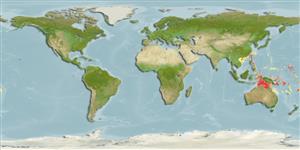>
Perciformes/Scorpaenoidei (Scorpionfishes) >
Triglidae (Searobins) > Triglinae
Etymology: Lepidotrigla: Greek, lepis, lepidos = scale + Greek, trigla, es = red mullet (Ref. 45335).
Eponymy: Dr Barry C Russell is an Australian ichthyologist who was Director of Research and Collections (now Curator Emeritus) at the Museum of the Northern Territory, Darwin (1982–present). [...] (Ref. 128868), visit book page.
Environment: milieu / climate zone / kisaran kedalaman / distribution range
Ekologi
laut dasar (demersal). Tropical
Western Central Pacific: northeast of Goulburn Island, Northern Territory, Australia.
Size / Weight / umur
Kematangan: Lm ? range ? - ? cm
Occurs over soft bottom of the continental shelf (Ref. 75154). Type specimen taken from 55 m depth (Ref. 33021). Better reference needed.
Eschmeyer, W.N. (ed.), 1999. Catalog of fishes. Updated database version of November 1999. Catalog databases as made available to FishBase in November 1999. (Ref. 33021)
Status IUCN Red List (Ref. 130435: Version 2025-1)
ancaman kepada manusia
Harmless
penggunaan manusia
Perikanan: tidak ada kepentingan
Alat, peralatan
laporan khas
muat turun XML
Sumber internet
Estimates based on models
Preferred temperature (Acuan
123201): 22 - 28.2, mean 26.8 °C (based on 240 cells).
Phylogenetic diversity index (Acuan
82804): PD
50 = 0.5000 [Uniqueness, from 0.5 = low to 2.0 = high].
Bayesian length-weight: a=0.01000 (0.00244 - 0.04107), b=3.04 (2.81 - 3.27), in cm total length, based on all LWR estimates for this body shape (Ref.
93245).
Trophic level (Acuan
69278): 3.4 ±0.3 se; based on size and trophs of closest relatives
Daya lenting (Acuan
120179): Tinggi, Waktu penggandaan populasi minimum kurang dari 15 bulan (Preliminary K or Fecundity.).
Fishing Vulnerability (Ref.
59153): Low vulnerability (10 of 100).
🛈
